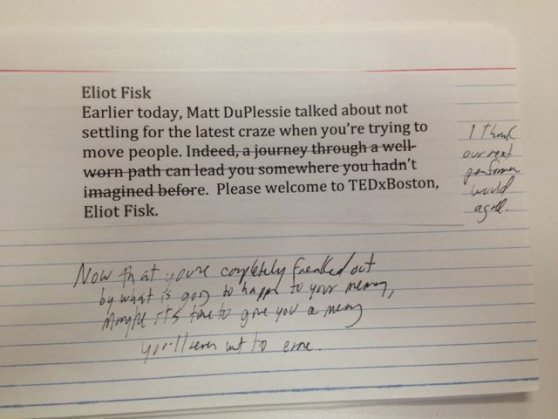This month, among other things, we’ll be looking back at our work in June for TEDxBoston and TED Global. First, let’s consider one of the smallest elements of these events: the speaker introductions. As a TEDxBoston curator, I recognize that the intros are navigational overhead. No one comes to the events for the intros; I’ve never walked out of a day of TED and heard anyone say, “That 18-minute talk about how to cure cancer was OK, I guess, but the intro was awesome.” The job of the introducer is to offer some space between the featured speakers and performers, create some context, and get off the stage as quickly as possible so the show can go on.
Still, curators who want to make an impact obsess over their intros. They’re brief, we’re not sure if people are really listening, but we want them to count. And, after we’ve crafted an intro, we print it on a card and hold it before us. That’s what I did at last week’s TEDxBoston (even though I’ve gotten into trouble reading notes on the TED stage before). During the first set, my intros were brief, useful … and stiff. They were stiff because I was reading from cards. The three-or-four-sentence-long intros were short enough for me to memorize. But, because I had the cards in front of me, I looked at them constantly, even though I knew them by heart.
During the break between sets, I decided this approach wasn’t working. I knew what I wanted to say, I knew how to pronounce the speakers’ names. Why not just talk? I left the cards at my seat. Did I follow the script to the last syllable? No. Did it matter? Also no. I felt freer without the 4×6 index card in my hand screaming for attention; I had more confidence without the crutch. And, during the reception afterward, two people brought up one of my second-set intros. No one mentioned any of the intros I read during the first set.
Especially when the talk is very short, try saying it without assistance. You might not get every word right, but there’s a good chance you’ll speak directly and in the moment you might get even closer to what you want to say when you were writing it down.





